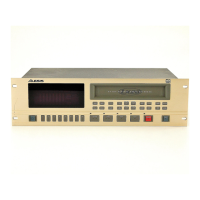Chapter 11 - Applications
ADAT LX20 Reference Manual 67
LIBRARIES AND ARCHIVES
The LX20 is superb for archiving purposes, such as speeches and broadcasts, stereo
mixes or libraries of stereo samples. The LX20 can record over eight hours of mono
material by recording approx. 60 minutes on each track (using ST-180 tape). Over
four hours of stereo mixes or samples can be recorded by mixing down to four sets of
stereo pairs (1/2, 3/4, 5/6, and 7/8).
MODULAR RECORDING
Collaborations work particularly well with a system consisting of two or more
LX20s (and/or ADATs). You can record your tracks onto the master machine, then do
a premix onto two tracks of a slave machine, which is perfectly synchronized to the
master. Send this tape to your partner, who adds parts on the other tracks. When
the tape comes back, just pop it into one of your machines, and your partner’s parts
will be in sync with the original tracks you laid down.
Include documentation with your tape that indicates info such as sample rate and
Locate Point positions. Or, if you’re both using BRC remotes, save your setup to the
“data” section of tape (this is called saving the Table of Contents, or TOC). This
way, you partner can pick up right where you left off.
COMPUTER CONTROL AND MIDI
MIDI SYSTEMS: VIRTUAL TRACKING
Many sequencing software manufacturers now integrate digital audio hard disk
recording and playback into their sequencers. However, these types of systems tax
computers to their limits, and in many cases require an expensive upgrade (faster
processor, more RAM, additional hard drives and cards, backup system for the
digital audio data, etc.) to obtain adequate results.
Synching your existing MIDI sequencer to an LX20 can offer much of the same
flexibility, as you can add digital audio to an existing sequence by recording into
the LX20 as you monitor the sequenced instruments. Conversely, you can record MIDI
data into the sequencer while it’s synched to the LX20.
Synchronizing the LX20 and sequencer requires a time code interface, such as the
Alesis BRC, Steinberg ACI, or JLCooper DataSync 2, allof which can convert the
LX20’s SYNC OUT to SMPTE or MIDI Time Code (the most common time references
for MIDI sequencers). Here’s the general hookup procedure.
• Connect the LX20’s SYNC OUT (or SYNC out from the last slave in a multiple
ADAT system) to the time code interface SYNC IN.
• Connect the timecode interface’s MIDI OUT to your sequencer’s MIDI IN.
• Set your sequencer to synchronize to the MTC being received from the time code
interface (usually by selecting the sequencer’s “MTC sync” mode). As you control
the LX20’s tape motion with the transport controls, the sequencer will
automatically follow along, letting you mix digital recordings with “virtual”
MIDI tracks recorded in a MIDI sequencer. However, virtual tracks also have
limitations, such as the occasional stuck note or limited polyphony.

